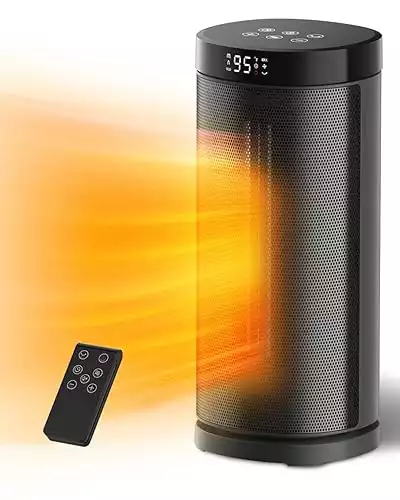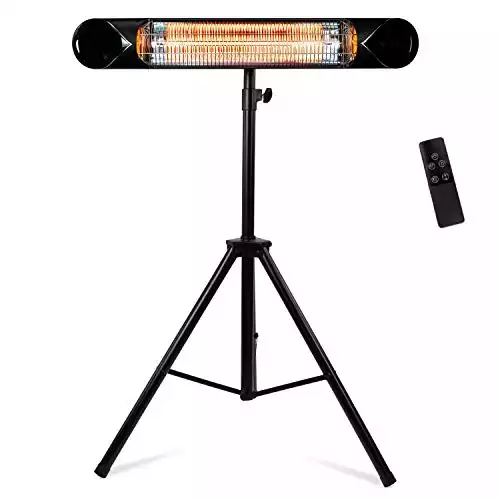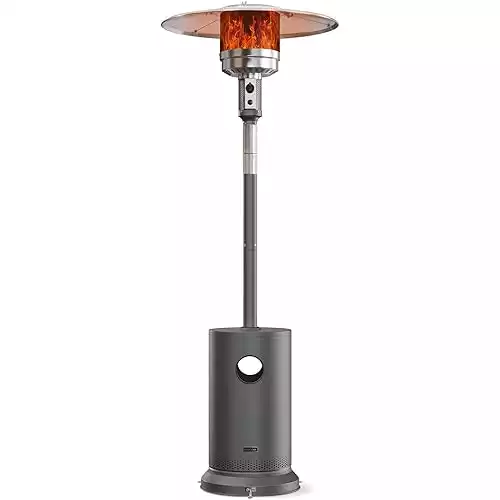

It’s cold outside but you’re not ready to head indoors. What’s the solution? You buy a patio heater.
If you’ve always wanted to stretch those long summer evenings, or simply need to entertain outside, there’s a patio heater to suit all budgets and spaces.
Here are your top three things to consider before you buy a patio heater for your garden.
1. How much BTU heat you need for the space you got
When you go to buy a patio heater you’ll notice that one of the many factors you’ll consider is the BTUs.
What is a BTU? It stands for British Thermal Unit. It’s an energy unit used to calculate heat in heaters, including the heaters in your home. It is approximately the energy needed to heat one pound of water by 1 degree Fahrenheit.
The higher the BTUs the more heat the outdoor heater will produce.
How to calculate how many BTU’s you need in patio heaters
The formula for calculating BTU’s is not complicated, but there are many X factors that are hard to calculate. But put simply:
- Calculate the size of your big your patio by multiplying length x width to calculate square footage. A rough estimate will do.
- Multiply the square footage by 20 BTU’s per square foot
Of course, those X factors then come into play
Is your patio in a sheltered spot? Will you be using it on a warm summer night, a blustery autumn day or a snowy winter evening?
Is your patio oddly shaped? How many people are you planning on entertaining? Is it a sun-facing patio?
That’s where the rest of the questions come into play.
2. So how many heaters do I really need?
By this basis, a patio heater with 10,000 BTUs should warm around 500 square feet. But as we’ve already seen, it can be a little more complicated than that.
So, for example, if you get one large heater, the heat will be concentrated and it may leave some of the areas of the patio cold. So it may be worth your while getting several smaller heaters and strategically placing them around the patio.
Get down to the nitty-gritty of your climate:
Whilst we can’t tell you how much wind or sun you get, we can give you a rough estimate depending on where you live. The below is roughly what you need to keep you warm:
- Warmer climates (Spain or Australia) – multiply this number by 10 – 15.
- Moderate climates (the United Kingdom or France) – multiply by 20 – 30.
- Cold climates (Scandinavia, Canada or the Northern United States) multiply the square foot number by 30 – 40.
Of course, you also have to consider the time of the year. If you live in Barcelona you probably only need some light patio heaters for your balcony in Winter.
If you need a patio heater, the calculation of 20x will work in the spring and autumn. If you are looking to cover a cold winter, and you have an unsheltered patio with no cover, you may need to go up to 30-40x.
3. Electric Vs Gas Heaters
When buying a patio heater, you will undoubtedly be presented by two main choice – you have Gas patio heaters and then you have electric heaters.
There are pros and cons to both. Gas heaters tend to be more powerful, but you need to be able to get the propane gas nearby and if you run out, you run out. They are also more expensive.
The best electric patio heaters are Infrared Electric Heaters. Why? Because they heat people and objects in their paths rather than the air around them.
They are more efficient and require less BTUs to heat people, but require outdoor plugs, so you may be limited as to where you can place them.
And as you probably need a couple of them to cover all angles, extension leads are a must.
What’s the eco-friendly patio heater?
All patio heaters use energy, and there’s very few clean energy. You can buy eco fire logs for your firepit, but that will still send particles in the air and create air pollution.
Overall, it’s cheaper and takes less energy to run electricity than to get gas. As electric heaters are more efficient, cheaper to run and require less energy they are the eco-friendly patio heating option.
Though obviously, there’s always more jumpers and blankets if you want to go full eco-friendly.
This 1,500W space heater offers fast heating, 3 timer modes, eco-friendly operation, and a noiseless 38dB design. It’s safe, energy-efficient, and ideal for bedrooms, offices, and other indoor spaces.
4. The practicalities of owning a Patio Heater
Once you’ve figured out how powerful you need your heater, you need to figure out where you will be storing your patio heaters
Wall-mounted electric patio heater needs to be more than splash proof – but electric heaters that you plug in and put away could probably just be made out of slightly less durable material as long as you can put them away in a garage or shed when you’re done using them.
However, if you are buying a gas heater, they tend to be larger and will simply live outside. A durable stainless steel design will be needed and it’s worth investing in a good cover to protect it.
No point spending all that money only to have it rust in the snow over winter.
What’s the best kind of infrared electric heaters
Vertical infrared heaters will provide the best heat coverage for a larger area. We like Tower Heaters because they spread the heat over a larger area. Multiple power levels are a must.
Avoid electric fan heaters. A fan electric heater wastes a huge amount of heat, so stick with infrared, preferably one that converts over 90% of its power to heat.
As long as you get one that can give you the maximum 2,000 watts that will give you the full range of heat.
The Briza heater offers dual mounting options, easy remote control, safety features, carbon infrared technology, 4-season protection, 3 heat levels, and a built-in timer for convenient, efficient heating indoors or outdoors.
What’s the best kind of gas patio heaters?
Mushroom heaters are still one of the best and most powerful gas heaters, mostly because they hide the propane gas tank inside the mechanism, are easy to use and give out heat over 360 degrees.
You want something that heats up quickly because on average patio heaters take longer to heat up the area than electric heaters. But they are more powerful. Add stainless steel designs and you’ve got a patio that will conquer snow, sea air, or even the harsh sun.
This 48,000 BTU outdoor heater heats an 18-foot diameter, is durable with double-layer heating mesh, features easy assembly, safety protections, and a patented round table design for added convenience.
FAQs
What are the different types of patio heaters?
Patio heaters come in gas (propane or natural gas), electric (infrared or halogen), and wood-burning options, each suited for different outdoor settings and heating needs.
How do I choose the best patio heater for my space?
Consider the size of your outdoor area, power source availability, safety features, weather resistance, and whether you need a portable or fixed model.
Are propane patio heaters better than electric ones?
Propane heaters provide strong, portable heat, while electric infrared models are energy-efficient and work well in covered or enclosed areas. The best choice depends on your usage needs.
How much heat output do I need for my patio?
A good rule of thumb is 10,000 BTUs per 100 square feet for gas heaters. For electric models, 1,500W is ideal for small areas, while larger patios may require multiple units.
Can patio heaters be used in enclosed spaces?
Electric infrared patio heaters are safe for enclosed or partially covered areas. Gas heaters require proper ventilation to prevent carbon monoxide buildup.
Are infrared patio heaters energy efficient?
Yes, infrared heaters directly warm people and objects instead of heating the air, making them more energy-efficient and effective in outdoor spaces.
What safety features should I look for in a patio heater?
Key safety features include tip-over protection, overheating shut-off, a cool-touch exterior, and stable base design to prevent accidents.
Can I use a patio heater on a wooden deck?
Yes, but ensure the heater has a stable base, tip-over protection, and is placed on a heat-resistant mat or positioned safely away from flammable materials.
How much does it cost to run a patio heater?
Propane heaters cost around $1.50–$3 per hour to operate. Electric heaters cost approximately $0.20–$0.50 per hour, depending on the wattage and local electricity rates.
Are patio heaters waterproof?
Most outdoor-rated heaters have IP34 or higher waterproof ratings, meaning they can handle light rain, but they should be stored or covered when not in use.
Do patio heaters work in the wind?
Infrared electric heaters work well in the wind since they heat objects, not the air. Gas heaters can struggle in strong winds but work well in sheltered areas.
How long does a propane tank last on a patio heater?
A 20 lb propane tank lasts about 8-10 hours on a standard 40,000 BTU patio heater, depending on the heat setting used.
Can I leave my patio heater outside all year?
While many heaters are weather-resistant, using a protective cover or storing them indoors during extreme weather will extend their lifespan.
How do I clean and maintain a patio heater?
Regularly wipe down the exterior, clear burner ports (for gas models), and check for leaks or loose connections to ensure safe operation.
Are patio heaters worth the investment?
Yes! A patio heater extends outdoor usability in colder months, providing warmth for gatherings, increasing comfort, and adding ambiance to patios, decks, and outdoor dining areas.











